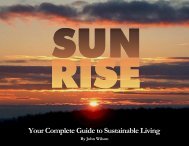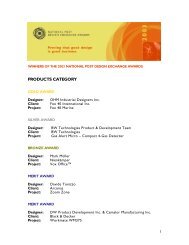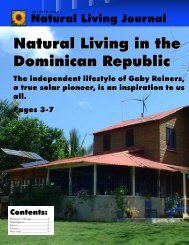Volume 3 - Program & Project Ideas (PDF - 4.5 - Natural Life Network
Volume 3 - Program & Project Ideas (PDF - 4.5 - Natural Life Network
Volume 3 - Program & Project Ideas (PDF - 4.5 - Natural Life Network
Create successful ePaper yourself
Turn your PDF publications into a flip-book with our unique Google optimized e-Paper software.
<strong>Natural</strong> Resources Canada – Community Energy Systems<br />
T.1.2 Commute trip reductions<br />
Commute Trip Reduction (also called Employee Trip Reduction or Vehicle Trip<br />
Reduction) programs give commuters resources and incentives to reduce their automobile<br />
trips. Commute trip reduction programs typically include some of the following<br />
strategies: parking management and pricing; telework; guaranteed ride home programs;<br />
and others.<br />
• Reduced automobile travel saves energy, reduces congestion, saves money in<br />
road construction and parking, increases road safety, protects the environment,<br />
makes efficient use of land, increases community livability and reduces<br />
employee costs associated with travel.<br />
-Additional resource<br />
TDM Encyclopedia, Chapter entitled, Commute Trip Reduction (CTR): <strong>Program</strong>s that<br />
Encourage Employees to Use Efficient Commute Options<br />
http://www.vtpi.org/tdm/tdm9.htm<br />
T.1.3 Parking management<br />
- Case study: Lyon, France<br />
Parking policies were developed for the city’s downtown. Sprawl was curbed through the<br />
elimination of 800 parking places on the surface and construction of underground<br />
facilities for 6000 parking places. The downtown area was protected by the location of<br />
car parks on the outskirts in the immediate proximity of major highway facilities. Parking<br />
supply was prioritized: short duration on the surface, medium duration underground, long<br />
duration underground for the long-term subscribers. The percentage of long-term parking<br />
for home/work trips is being reduced gradually. Certain car parks are reserved for<br />
residents.<br />
• Traffic in the in the downtown was reduced, saving energy and reducing CO2<br />
emissions.<br />
• Efficient use was made of land and services, curbing sprawl.<br />
Source: "Good Practice Guide" - The European Commission. 1996. Parking Management.<br />
http://www.iclei.org/LEICOMM/LEI-055.HTM<br />
- Case study: Portland, OR, USA<br />
The Tri-County Metropolitan Transportation District has implemented various parking<br />
management strategies around transit stations to minimize costs and support transitoriented<br />
development. It has arranged shared parking with Park & Ride and other types<br />
of land uses, including apartments, churches, movie theatres and government buildings<br />
near transit stations. Lower minimum parking requirements are permitted around transit<br />
stations. Park & Ride capacity near transit stations can be reduced if the land is used for<br />
transit oriented development, thus allowing car trips that access transit to be replaced by<br />
walk/bike trips.<br />
Draft 4/11/2005 60






